| Article ID | Journal | Published Year | Pages | File Type |
|---|---|---|---|---|
| 6151746 | European Journal of Internal Medicine | 2013 | 7 Pages |
Atypical hemolytic uremic syndrome (HUS) is a renal disease due to complement dysregulation. Many of the known causes of atypical HUS originate from genetic mutations of complement regulatory proteins, such as complement factor H (CFH) and thrombomodulin. However, atypical HUS has only a genetic penetrance of 40-50% of the cases and usually appears in adulthood. We introduce a novel factor that may be involved in the onset and development of atypical HUS, i.e. the endothelial surface glycocalyx. The glycocalyx is a highly interactive matrix covering the luminal side of vascular endothelial cells and consists of glycosaminoglycans, proteoglycans and glycoproteins, which has an important role in maintaining homeostasis of the vasculature. The surface-bound glycocalyx glycosaminoglycan constituent heparan sulfate is crucial for CFH binding and function, both in recognition of host tissue and prevention of spontaneous complement activation via the alternative pathway. Most of the clinically relevant genetic mutations in CFH result in incorrect binding to heparan sulfate. In addition, a role between proper function of thrombomodulin and the endothelial glycocalyx has also been observed. We suggest that not only changes in binding properties of the complement regulatory proteins play a role but also changes in the endothelial glycocalyx are involved in increased risk of clinical manifestation of atypical HUS. Finally, vascular glycocalyx heterogeneity in turn could dictate the specific vulnerability of the glomerular vascular bed in atypical HUS and may provide new therapeutic targets to intervene with endothelial cell activation and local complement pathway regulation.
